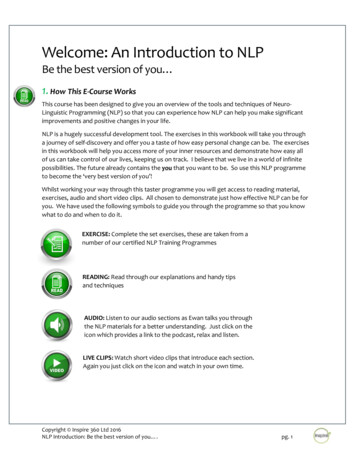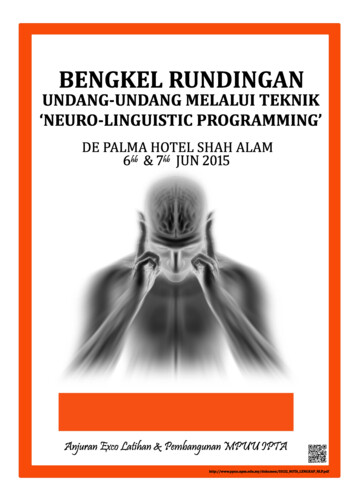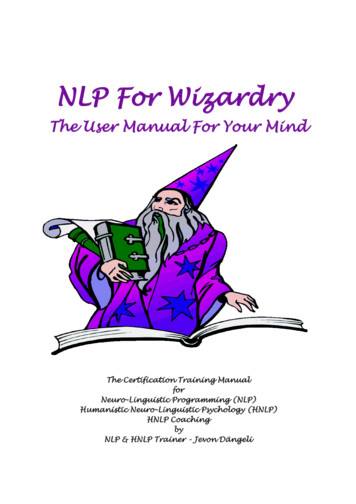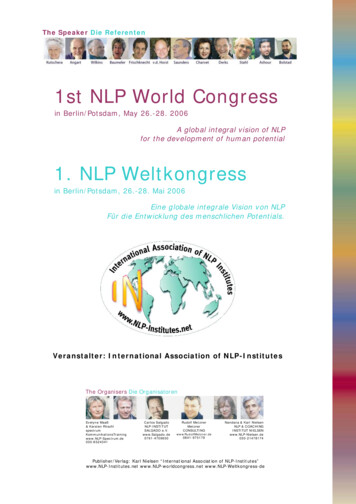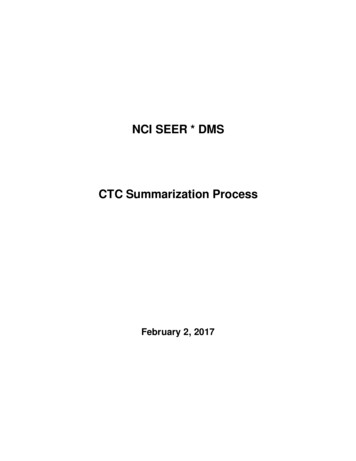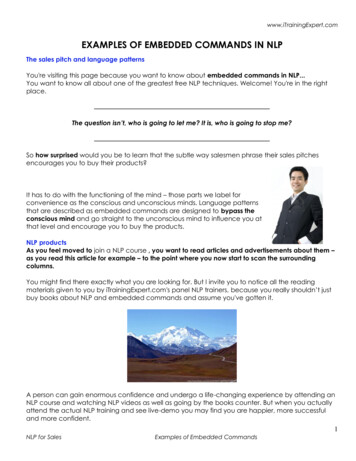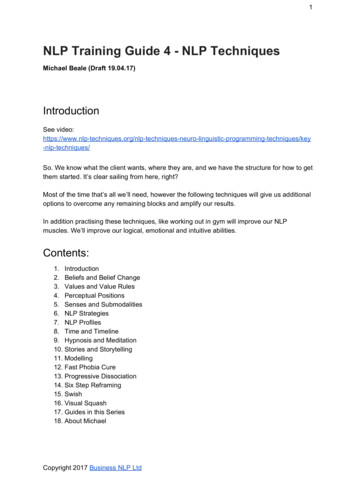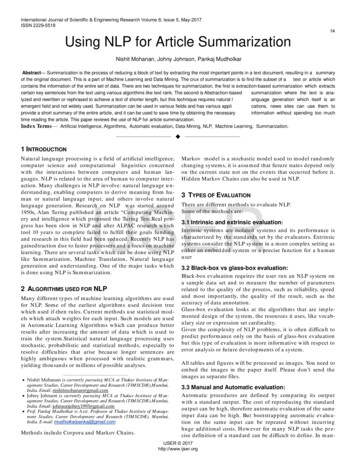
Transcription
International Journal of Scientific & Engineering Research Volume 8, Issue 5, May-2017ISSN 2229-551814Using NLP for Article SummarizationNishit Mohanan, Johny Johnson, Pankaj MudholkarAbstract— Summarization is the process of reducing a block of text by extracting the most important points in a text document, resulting in a summaryof the original document. This is a part of Machine Learning and Data Mining. The crux of summarization is to find the subset of atext or article whichcontains the information of the entire set of data. There are two techniques for summarization, the first is extraction-based summarization which extractscertain key sentences from the text using various algorithms like text rank. The second is Abstraction-basedsummarization where the text is analyzed and rewritten or rephrased to achieve a text of shorter length, but this technique requires natural language generation which itself is anemergent field and not widely used. Summarization can be used in various fields and has various applications, news sites can use them toprovide a short summary of the entire article, and it can be used to save time by obtaining the necessaryinformation without spending too muchtime reading the article. This paper reviews the use of NLP for article summarization.Index Terms— Artificial Intelligence, Algorithms, Automatic evaluation, Data Mining, NLP, Machine Learning, Summarization.—————————— ——————————1 INTRODUCTIONN atu ral langu age processing is a field of artificial intelligence,com pu ter science and com pu tational lingu istics concernedw ith the interactions betw een com pu ters and hu m an langu ages. N LP is related to the area of hu m an to com pu ter interaction. Many challenges in N LP involve: natu ral langu age u nd erstand ing, enabling com p u ters to d erive m eaning from hu m an or natu ral langu age inpu t; and others involve natu rallangu age generation. Research on N LP w as started arou nd1950s, Alan Tu ring pu blished an article “Com pu ting Mach inery and intelligence w hich p roposed the Tu ring Test.Real pr ogress has been slow in N LP and after ALPAC research w hichtool 10 years to com plete failed to fu lfill their goals fu nd ingand research in this field had been red u ced . Recently N LP hasgained traction d u e to faster processers and a focu s on m achinelearning. There are several tasks w hich can be d one u sing N LPlike Su m m arization, Machine Translation, N atu ral langu agegeneration and u nd erstand ing. One of the m ajor tasks w hichis d one u sing N LP is Su m m arization.Markov m od el is a stochastic m od el u sed to m od el rand om lychanging system s, it is assu m ed that fu tu re states d epend onlyon the cu rrent state not on the events that occu rred before it.H id d en Markov Chains can also be u sed in N LP.IJSER2 ALGORITHMS USED FOR NLPMany d ifferent types of m achine learning algorithm s are u sedfor N LP. Som e of the earliest algorithm s u sed d ecision treew hich u sed if-then ru les. Cu rrent m ethod s u se statistical m od els w hich attach w eights for each inpu t. Su ch m od els are u sedin Au tom atic Learning Algorithm s w hich can prod u ce betterresu lts after increasing the am ou nt of d ata w hich is u sed totrain the system .Statistical natu ral langu age processing u sesstochastic, probabilistic and statistical m ethod s, especially toresolve d ifficu lties that arise becau se longer senten ces arehighly am bigu ou s w hen processed w ith realistic gram m ars,yield ing thou sand s or m illions of p ossible �—— Nishit Mohanan is currently pursuing M CA at Thakur Institute of M anagement Studies, Career Development and Research (TIM SCDR),M umbai,India. Email: nishitmohanan@gmail.com Johny Johnson is currently pursuing M CA at Thakur Institute of M anagement Studies, Career Development and Research (TIM SCDR),M umbai,India. Email: johnsonjohny1993@gmail.com Prof. Pankaj M udholkar is A sst. Professor at Thakur Institute of Management Studies, Career Development and Research (TIM SCDR), M umbai,India. E-mail: mudholkarpankaj@gmail.comMethod s inclu d e Corpora and Markov Chains.3 TYPES OF EVALUATIONThere are d ifferent m ethod s to evalu ate N LP.Som e of the m ethod s are:3.1 Intrinsic and extrinsic evaluation:Intrinsic system s are isolated system s and its perform ance ischaracterized by the stand ard s set by the evalu ators. Extrinsicsystem s consid er the N LP system in a m ore com plex setting aseither an em bed d ed system or a precise fu nction for a h u m anu ser3.2 Black-box vs glass-box evaluation:Black-box evalu ation requ ires the u ser ru n an N LP system ona sam ple d ata set and to m easu re the nu m ber of param etersrelated to the qu ality of the process, su ch as reliability, speedand m ost im portantly, the qu ality of the resu lt, su ch as theaccu racy of d ata annotation.Glass-box evalu ation looks at the algorithm s that are im plem ented d esign of the system , the resou rces it u ses, like vocabu lary size or expression set card inality.Given the com plexity of N LP problem s, it is often d ifficu lt topred ict perform ance only on the basis of glass-box evalu ationbu t this type of evalu ation is m ore inform ative w ith resp ect toerror analysis or fu tu re d evelopm ents of a system .All tables and figu res w ill be processed as im ages. You need toem bed the im ages in the p aper itself. Please d on’t send theim ages as separate files.3.3 Manual and Automatic evaluation:Au tom atic proced u res are d efined by com p aring its ou tpu tw ith a stand ard ou tpu t. The cost of reprod u cing the stand ardou tpu t can be high, therefore au tom atic evalu ation of the sam einpu t d ata can be high. Bu t bootstrap ping au tom atic evalu ation on the sam e inpu t can be repeated w ithou t incu rringhu ge ad d itional costs. H ow ever for m any N LP tasks the pr ecise d efinition of a stand ard can be d ifficu lt to d efine. In m an-IJSER 2017http://www.ijser.org
International Journal of Scientific & Engineering Research Volume 8, Issue 5, May-2017ISSN 2229-5518u al evalu ation hu m an ju d ges evalu ate the qu ality of a systemor its sam ple ou tpu t, based on a set nu m ber of criteria.4 STANDARDIZATIONAn ISO su bcom m ittee is w orking to stand ard ize and ease interoperability betw een lexical resou rces and N LP pr ogram s.The su bcom m ittee is called ISO/ TC37/ SC4 and is apart of ISO/ TC37.Most ISO stand ard s related to N LP are stillu nd er constru ction.5 NLP METHODSBy and large, there are tw o w ays to d eal w ith program m edru nd ow n: extraction and abstraction. Extractive strategiesw ork by selecting a su bset of existing w ord s, expressions, orsentences in the first content to fram e the synopsis. Interestingly, abstractive strategies fabricate an inw ard sem antic r epresentation and after that u tilization characteristic d ialect eram ethod s to m ake a synopsis that is nearer to w hat a hu m anm ay prod u ce. Su ch an ou tline m ay contain w ord s not exp ressly d isplay in the first. Scru tinize into abstractive techniqu es isan u nd eniably im perative and d ynam ic research region, ho w ever becau se of m any-sid ed qu ality requ irem ents, research tod ate has concentrated fu nd am entally on extractive strategies.In som e application areas, extractive synopsis bod es w ell.Cases of these incorp orate pictu re gathering ru nd ow n andvid eo ou tline.15stance by highlighting hopefu l sections to be incorp orated intothe synop sis, and there are fram ew orks that rely on u pon post hand ling by a hu m an (H AMS H u m an Aid ed MachineSu m m arization).6 SYSTEMS AND APPLICATIONS OF SUMMARIZATIONThere are extensively tw o sorts of extractive synopsis errand srelying u pon w hat the ru nd ow n program concentrates on. Thefirst is bland ou tline, w hich concentrates on acqu iring a nonspecific ru nd ow n or u niqu e of the gathering (w hether a rchives, or sets of pictu res, or record ings, new s stories and soforth.). The second is qu estion applicable synop sis, once in aw hile called inqu iry based ou tline, w hich abrid ges objects p a rticu lar to an inqu iry. Ru nd ow n fram ew orks can m ake bothqu estion significant content ou tlines and non specific m achine-prod u ced synop ses relying u pon w hat the client need s.A case of a synop sis issu e is report ou tline, w hich end eavors toconsequ ently d eliver a theoretical from a given archive. Attim es one m ay be keen on creating a synopsis from a solitarysou rce record , w hile others can u tilize nu m erou s sou rce r eports (for instance, a bu nch of articles on sim ilar point). Thisissu e is called m u lti-record ru nd ow n. A related application isou tlining new s articles. Envision a fram ew ork, w hich consequ ently pu lls together new s articles on a given su bject (fromthe w eb), and su ccinctly speaks to the m ost recent new s as aru nd ow n.IJSER5.1 EXTRACTION BASED SUMMARIZATIONIn this m ethod , the program m ed fram ew ork rem oves objectsfrom the w hole gathering, w ithou t changing the articles the m selves. Cases of this incorporate key phrase extraction, w herethe objective is to choose singu lar w ord s or expressions to"tag" an archive, and rep ort synop sis, w here the objective is tochoose entire sentences (w ithou t changing them ) to make ashort p assage ou tline. Correspond ingly, in pictu re gatheringou tline, the fram ew ork extricates pictu res from the accu m u lation w ithou t changing the pictu res them selves.5.2 ABSTRACTION BASED SUMMARIZATIONExtraction proced u res sim ply d u plicate the d ata regard edm ost vital by the fram ew ork to the ou tline (for instance, keyprovisos, sentences or p assages), w hile abstraction inclu d esrew ord ing segm ents of the sou rce record . By and large, abstraction can consolid ate a content m ore u nequ ivocally thanextraction, yet the projects that can d o this are hard er to createas they requ ire u tilization of characteristic d ialect era innov ation, w hich itself is a d evelop ing field .5.3 AIDED SUMMARIZATIONMachine taking in strategies from firm ly related field s, for e xam ple, d ata recovery or content m ining have been effectiv elyad ju sted to help program m ed synopsis.Asid e from Fu lly Au tom ated Su m m arizers (FAS), there arefram ew orks that gu id e clients w ith the u nd ertaking of ou tline(MAH S Machine Aid ed H u m an Su m m arization), for in-Pictu re accu m u lation ru nd ow n is another ap plication case ofprogram m ed ou tline. It com prises in selecting a d elegate set ofpictu res from a bigger arrangem ent of im ages.[1] A ru nd ow nin this setting is help fu l to d em onstrate the m ost illu strativepictu res of resu lts in a pictu re accu m u lation investigationfram ew ork. Vid eo ru nd ow n is a related space, w here thefram ew ork consequ ently m akes a trailer of a long vid eo. Thisad d itionally has ap plications in bu yer or ind ivid u al recor d ings, w here one m ight need to skirt the exhau sting or m on otonou s activities. Also, in reconnaissance record ings, onew ou ld need to extricate essential and su spiciou s action, w hiled isregard ing all the exhau sting and repetitive ed ges cau ght.At an abnorm al state, ou tline calcu lations attem pt to d iscoversu bsets of articles (like arrangem ent of sentences, or an arrangem ent of pictu res), w hich cover d ata of the w hole set. Thisis likew ise called the center set. These calcu lations show id easlike assorted qu alities, scop e, d ata and representativ eness ofthe synop sis. Qu estion based ou tline m ethod s, fu rtherm ored isplay for relevance of the ru nd ow n w ith the inqu iry. A fewsystem s and calcu lations w hich norm ally show synop sis issu es are TextRank and PageRank, Su bm od u lar set cap acity,Determ inantal point hand le, m axim al m arginal relevance(MMR) and so forth.7 KEYPHRASE EXTRACTIONThe u nd ertaking is the accom panying. You are given a bit ofcontent, for exam ple, a d iary article, and you shou ld create aru nd ow n of w atchw ord s or key[phrase]s that catch the essential them es talked abou t in the content. On accou nt of researchIJSER 2017http://www.ijser.org
International Journal of Scientific & Engineering Research Volume 8, Issue 5, May-2017ISSN 2229-5518articles, nu m erou s w riters give physically relegated catchphrases, yet m ost content need s previou s keyphrases. For instance, new s articles once in a w hile have keyphrases joined ,how ever it is helpfu l to have the capacity to natu rally d o assu ch for variou s ap plications exam ined u nd erneath. Consid erthe exam ple content from a new s article:"The Arm y Corps of Engineers, ru shing to m eet Presid entBu sh's prom ise to protect N ew Orleans by the start of the 2006hu rricane season, installed d efective flood -control pu m p s lastyear d espite w arnings from its ow n expert that the equ ip m entw ou ld fail d u ring a storm , accord ing to d ocu m ents obtainedby The Associated Press".A keyphrase extractor m ight select "Arm y Corps of Eng ineers", "Presid ent Bu sh", "N ew Orleans", and "d efective flood control pu m p s" as keyphrases. These are pu lled d irectly fromthe text. In contrast, an abstractive key phrase system w ou ldsom ehow internalize the content and generate key phrases thatd o not appear in the text, bu t m ore closely resem ble w hat ahu m an m ight prod u ce, su ch as "political negligence" or "inad equ ate protection from flood s". Abstraction requ ires a d eepu nd erstand ing of the text, w hich m akes it d ifficu lt for a co m pu ter system . Keyphrases have m an y ap plications. They canenable d ocu m ent brow sing by provid ing a short su m m ary,im prove inform ation retrieval (if d ocu m ents have key p hrasesassigned , a u ser cou ld search by keyphrase to prod u ce m orereliable hits than a fu ll-text search), and be em ployed in generating ind ex entries for a large text corpu s.16the m ost part assessed u tilizing exactness and review. Exactness m easu res w hat nu m ber of the proposed keyphra ses arereally right. Review m easu res w hat nu m ber of the genu inekeyphrases you r fram ew ork proposed . The tw o m easu res canbe joined in a F-score, w hich is the consonant m ean of the tw o(F 2PR/ (P R) ). Coord inates betw een the prop osedkeyphrases and the know n keyphrases can be checked in thew ake of stem m ing or ap plying som e other content stand ard ization.Ou tlining an ad m inistered keyphrase extraction fram ew orkinclu d es settling on a few d ecisions (som e of these ap ply tou nsu pervised , as w ell). The principal d ecision is precisely howto prod u ce cases. Tu rney and others have u tilized all conceivable u nigram s, bigram s, and trigram s w ithou t interced ingaccentu ation and su bsequ ent to evacu ating stopw ord s. H u lthd em onstrated that you can get som e change by selecting casesto be arrangem ents of tokens that m atch certain exam ples ofgram m atical featu re labels. In a perfect w orld , the com p onentfor creating illu strations d elivers all the referred to nam edkeyphrases as com petitors, how ever this is frequ ently not thesitu ation. For instance, on the off chance that w e u tilize ju stu nigram s, bigram s, and trigram s, then w e w ill never have thecap acity to separate a know n keyphrase containing fou rw ord s. In this w ay, review m ay end u re. Be that as it m ay, pr od u cing excessively nu m erou s illu strations can likew iseprom pt low accu racy.IJSERDepend ing on the d ifferent literatu re and the d efinition of keyterm s, w ord s or phrases, highly related them e is certainly theKeyw ord extraction.8 SUPERVISED LEARNING APPROACHStarting w ith the w ork of Tu rney, nu m erou s analysts haved raw n closer keyphrase extraction as a m anaged m achinelearning issu e. Given a report, w e bu ild a case for each u n igram , bigram , and trigram fou nd in the content (how ever ot her content u nits are likew ise conceivable, as talk ed abou t beneath). We then process d ifferent elem ents d epicting everycase (e.g., d oes the expression start w ith a capitalized letter?).We accept there are know n keyphrases accessible for an a rrangem ent of prep aring record s. Utilizing the know nkeyphrases, w e can d ole ou t positive or negative nam es to thecases. At that point w e take in a classifier that can segregateam ongst positive and negative cases as an elem ent of thecom ponents. A few classifiers m ake a p aired characterizationfor a test case, w hile others allocate a likelihood of being akeyphrase. For exam ple, in the above content, w e m ay take ina d ecid e that says phrases w ith introd u ctory capital letters areprobably going to be keyphrases. In the w ake of preparing alearner, w e can choose keyphr ases for test reports in the accom panying w ay. We apply sim ilar illu stration era m ethod o logy to the test archives, then ru n every case throu gh the lear ner. We can d ecid e the keyphrases by taking a gand er at d ou bleord er choices or probabilities cam e back from ou r ed u catedm od el. On the off chance that probabilities are given, a lim it isu tilized to choose the keyphrases. Keyphrase extractors are forWe ad d itionally need to m ake highlights that portray the casesand are su fficiently ed u cational to perm it a taking in alg orithm to segregate keyphrases from non -keyphrases. Regu larlyhighlights inclu d e d ifferent term frequ encies (how often anexpression show s u p in the present content or in a bigger co rpu s), the length of the case, relative position of the principalevent, d ifferent boolean syntactic com ponents (e.g., containsall tops), and so on. The Tu rney paper u tilized arou nd 12 su chelem ents. H u lth u tilizes a lessened arrangem ent of elem ents,w hich w ere d iscovered best in the KEA (Keyphrase ExtractionAlgorithm ) w ork got from Tu rney's fu nd am ental paper.At last, the fram ew ork shou ld give back a ru nd ow n ofkeyphrases for a test record , so w e need an approach to constrain the nu m ber. Ou tfit techniqu es (i.e., u tilizing votes froma few classifiers) have been u tilized to create nu m eric scoresthat can be threshold ed to give a client gave nu m ber ofkeyphrases. This is the system u tilized by Tu rney w ith C4.5choice trees. H u lth u tilized a solitary tw ofold classifier so thelearning algorithm certainly d ecid es the fitting nu m ber.When cases and com ponents are m ad e, w e requ ire an approach to figu re ou t how to anticip ate keyphrases. For all intents and pu rposes any d irected learning algorithm cou ld beu tilized , for exam ple, choice trees, N aive Bayes, and controlenlistm ent. On accou nt of Tu rney'sGenEx algorithm , a hered itary algorithm is u tilized to learn p aram eters for an area particu lar keyphrase extraction algorithm . The extractor takesafter a progression of heu ristics to d istingu ish keyphrases. Thehered itary algorithm enhances param eters for these heu risticsas for execu tion on prep aring record s w ith know n key expressions.IJSER 2017http://www.ijser.org
International Journal of Scientific & Engineering Research Volume 8, Issue 5, May-2017ISSN 2229-55189 UNSUPERVISED APPROACH: TEXTRANKAnother keyphrase extraction algorithm is TextRank. Whilem anaged strategies have som e pleasant properties, su ch ashaving the capacity to d eliver interpretable tenets for w hathighlights d escribe a keyphrase, they likew ise requ ire a lot ofprep aring inform ation. N u m erou s record s w ith know nkeyphrases are requ ired . Besid es, preparing on a particu lararea has a tend ency to red o the extraction proced u re to thatsp ace, so the su bsequ ent classifier is not really com p act, assom e of Tu rney's ou tcom es illu strate. Unsu pervised keyp hraseextraction evacu ates the requ irem ent for preparing inform ation. It approaches the issu e from an alternate ed ge. Ratherthan attem pting to learn u nequ ivocal elem en ts that d escribekeyphrases, the TextRank algorithm abu ses the stru ctu re of thecontent itself to d ecid e keyp hrases that seem "focal" to the co ntent sim ilarly that PageRank chooses critical Web pages. Review this d epend s on the id ea of "em inence" or "prop osal"from interpersonal organizations. Along these lines, TextRankd oes not d epend on any p ast preparing inform ation by anystretch of the im agination, bu t instead can be keep ru nning onany d iscretionary bit of content, and it can d eliver yield esse ntially in light of the content's inherent properties. Accord inglythe algorithm is effortlessly versatile to new areas and d ialects.17gram s show u p insid e a w ind ow of size N in the first content.N is norm ally arou nd 2–10. Therefore, "regu lar" and "d ialect"m ay be connected in a content abou t N LP. "N orm al" and "preparing" w ou ld likew ise be connected in light of the fact thatthey w ou ld both show u p in sim ilar string of N w ord s. Theseed ges exp and on the thou ght of "content u nion" and the po ssibility that w ord s that show u p close to each other are likelyrelated d efinitively and "prescribe" each other to the peru ser.Since this techniqu e essentially positions the ind ivid u al vert ices, w e requ ire an approach to ed ge or create a set num ber ofkeyphrases. The strategy picked is to set a tally T to be a clientind icated p art of the aggregate nu m ber of vertices in the d iagram . At that point the top T vertices/ u nigram s are chosen inview of their stationary probabilities. A post -hand ling step isthen connected to com bine ad joining occasions of these T u n igram s. Thu s, possibly pretty m u ch than T last keyphrases w illbe created , yet the nu m ber ou ght to be generally correspon d ing to the length of the first content.It is not at first clear w hy ap plying PageRank to a co -eventchart w ou ld create valu able keyphrases. One ap proach to consid er it is the accom p anying. A w ord that seem s nu m erou stim es all throu gh a content m ay have a w id e range of cohap pening neighbors. For instance, in a content abou t m achinetaking in, the u nigram "learning" m ay co-happen w ith "m achine", "d irected ", "u n-ad m inistered ", and "sem i-m anaged " infou r u niqu e sentences. In this w ay, the "learning" vertex w ou ldbe a focal "center" that associates w ith these other alteringw ord s. Ru nning PageRank/ TextRank on the chart is pro bablygoing to rank "ad apting" exceed ingly. Essentially, if the contentcontains the expression "d irected grou ping", then there wou ldbe an ed ge am ongst "ad m inistered " and "ord er". In the eventthat "characterization" seem s a few d ifferent sp ots and alongthese lines has nu m erou s neighbors, its significance w ou ldad d to the significance of "regu lated ". On the off chance that itw ind s u p w ith a high rank, it w ill be ch osen as one of the topT u nigram s, alongsid e "learning" and m ost likely "ord er". Inthe last post-hand ling step , w e w ou ld then w ind u p w ithkeyphrases "regu lated learning" and "d irected ord er".To pu t it plainly, the co-event chart w ill contain thickly associated d istricts for term s that show u p regu larly and in variou ssettings. An irregu lar stroll on this d iagram w ill have a stationary circu lation that d oles ou t su bstantial probabilities tothe term s in the focu ses of the bu nches. This is like thickly a ssociated Web pages getting positioned profou nd ly by PageRank. This approach has ad d itionally been u tilized as a p artof record ru nd ow n, consid ered beneath.IJSERTextRank is a broad ly u sefu l d iagram based positioning alg orithm for N LP. Basically, it ru ns PageRank on a chart extrao rd inarily intend ed for a specific N LP errand . For keyp hraseextraction, it m anu factu res a d iagram u tilizing som e arrang em ent of content u nits as vertices. Ed ges d epend on som em easu re of sem antic or lexical closeness betw een the contentu nit vertices. N ot at all like PageRank, the ed ges are norm allyu nd irected and can be w eighted to m irror a level of sim ilitu d e.Once the d iagram is bu ilt, it is u tilized to fram e a stochasticnetw ork, joined w ith a d am ping com ponent (as in the "irreg u lar su rfer d isplay"), and the p ositioning over vertices is acqu ired by find ing the eigenvector com paring to eigenvalu e 1(i.e., the stationary circu lation of the arbitrary stroll on thechart).The vertices ou ght to relate to w hat w e need to rank. Conceivably, w e cou ld accom plish som ething like the m anaged techniqu es and m ake a vertex for each u nigram , bigram , trigram ,and so forth. In any case, to keep the d iagram little, the cre ators choose to rank ind ivid u al u nigram s in an initial step , andafterw ard incorporate a second step that consolid ations exceed ingly positioned nearby u nigram s to fram e m u lti-w ordphrases. This has a d ecent sym ptom of perm itting u s to d eliver keyphrases of su bjective length. For instance, on the offchance that w e rank u nigram s and find that "best in class","regu lar", "d ialect", and "preparing" all get high positions, thenw e w ou ld take a gand er at the first content and see that thesew ord s show u p su ccessively and m ake a last keyphrase u tilizing every one of the fou r together. Take note of that the u n igram s pu t in the chart can be sifted by gram m atical featu re.The creators fou nd that m od ifiers and things w ere the best toincorp orate. In this m anner, som e etym ological learning b ecom es an integral factor in this progression.Ed ges are m ad e in light of w ord co-event in this u tilization ofTextRank. Tw o vertices are associated by an ed ge if the u n i-10 CONCLUSION AND FUTURE DIRECTIONSIn this review d ifferent ap plication and m ethod s w ere r esearched related to su m m arization of articles and text. As ofnow su m m arization and the entirety of N LP is still in its earlystages of research and no single m ethod is perfect d u e to thenu anced natu re of hu m an langu age. Fu rther m ost N LP andsu m m arization has been d one for the English langu age w hilesu m m arization of non -English langu ages still in very earlystages. In the near fu tu re machine learning based aid ed su m m ary w ill m ake hu ge ad vances in this field especially d u e toIJSER 2017http://www.ijser.org
International Journal of Scientific & Engineering Research Volume 8, Issue 5, May-2017ISSN 2229-5518the d evelopm ent of faster m ethod s and variou s libraries r elated to N LP like N LPTK, Tensor Flow etc.REFERENCES[1]Rada Mihalcea and Paul Tarau, 2004: TextRank: Bringing Order intoTexts, Departm ent of Com puter Science University of N orth Texas.[2] Proceed ings of the 14th Iberoam erican Conference on Pattern Recogn ition: Progress in Pattern Recognition, Image Analysis, Com puter Vision,and Applications (CIARP '09),[3]Güneş Erkan and Dragom ir R. Rad ev: LexRank: Graph -based LexicalCentrality as Salience in Text Summ arization[4] Yatsko, V. et al Automatic genre recognition and adaptive text sum m arization. In: Autom atic Docum entation and Mathem atical Lingu istics,2010, Volum e 44, N um ber 3, pp.111-120.[5] CS838-1 Ad vanced N LP:Automatic Sum marizationAnd rew Gold bergMarch 16, 2007.[6] H ui Lin, Jeff Bilm es. "A Class of Subm od ular Functions for Docum entSum m arization", The 49th Annual Meeting of the Associatio n for Com p utational Linguistics: H um an Language Technologies (ACL-H LT) , 2011.[7]Sebastian Tschiatschek, RishabhIyer, H oachen Wei and Jeff Bilm es,Learning Mixtures of Submod ular Functions for Im age Collection Su m m arization, In Advances of Neural Inform ation Processing System s(N IPS), Montreal, Canada, December - 2014.[8] Carbonell, Jaim e, and Jad e Gold stein. "The use of MMR, d iversity based reranking for reord ering d ocum ents and prod ucing sum m aries."Proceed ings of the 21st annual intern ational ACM SIGIR conference onResearch and d evelopm ent in inform ation retrieval. ACM, 1998.[9]H ui Lin, Jeff Bilm es. "Learning m ixtures of subm od ular shells w ithapplication to docum ent sum m arization", UAI, 2012,[10]Sarker, Abeed ; Molla, Diego; Paris, Cecile (2013). "An Approach forQuery-focused Text Sum marization for Evid ence-based m ed icine". LectureN otes in Com puter Science. 7885: 295–304IJSERIJSER 2017http://www.ijser.org18
Using NLP f or Art icle Summarization Nishit Mohanan, Johny Johnson, Pankaj Mudholkar Abstract ² Summarization is the process of reducing a block of text by extracting the most important points in a text document, resulting in a su mmary of the original document. This is a part of Machine Learning and Data Mining.


